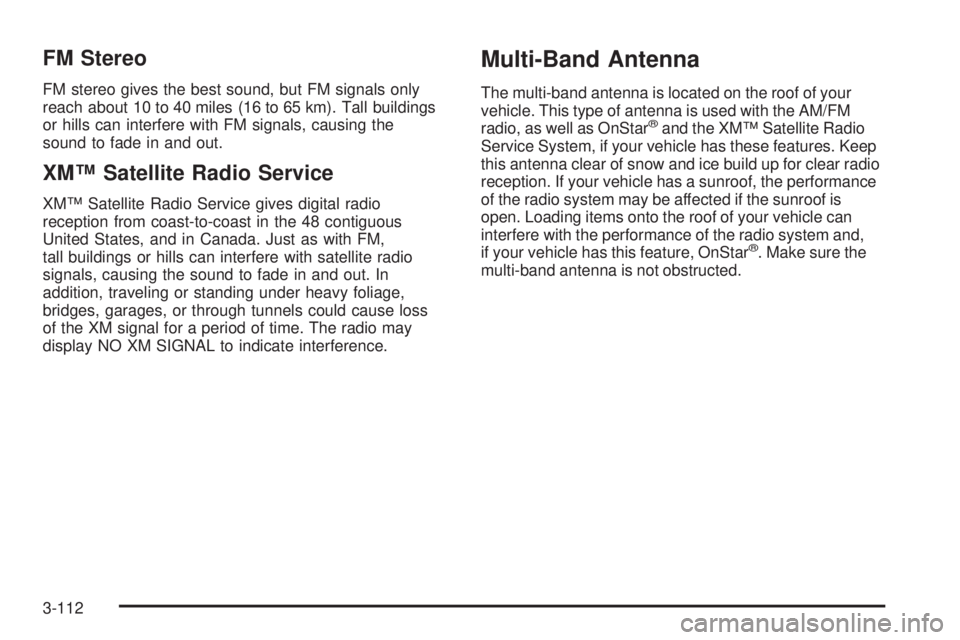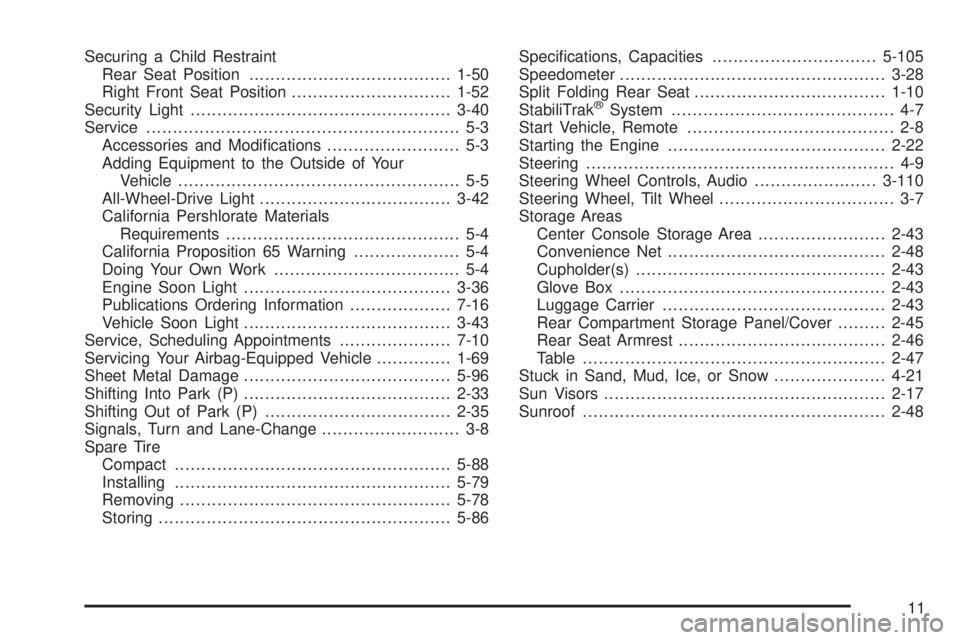2008 PONTIAC TORRENT sunroof
[x] Cancel search: sunroofPage 1 of 434

Seats and Restraint Systems........................... 1-1
Front Seats
............................................... 1-2
Rear Seats
..............................................1-10
Safety Belts
.............................................1-12
Child Restraints
.......................................1-31
Airbag System
.........................................1-56
Restraint System Check
............................1-71
Features and Controls..................................... 2-1
Keys
........................................................ 2-3
Doors and Locks
......................................2-11
Windows
.................................................2-15
Theft-Deterrent Systems
............................2-17
Starting and Operating Your Vehicle
...........2-20
Mirrors
....................................................2-37
OnStar
®System
......................................2-39
Storage Areas
.........................................2-43
Sunroof
..................................................2-48
Instrument Panel............................................. 3-1
Instrument Panel Overview
.......................... 3-4
Climate Controls
......................................3-20
Warning Lights, Gages, and Indicators
........3-26
Driver Information Center (DIC)
..................3-45
Audio System(s)
.......................................3-67Driving Your Vehicle....................................... 4-1
Your Driving, the Road, and Your Vehicle
..... 4-2
Towing
...................................................4-27
Service and Appearance Care.......................... 5-1
Service
..................................................... 5-3
Fuel
......................................................... 5-5
Checking Things Under the Hood
...............5-10
All-Wheel Drive
........................................5-44
Headlamp Aiming
.....................................5-46
Bulb Replacement
....................................5-47
Windshield Wiper Blade Replacement
.........5-51
Tires
......................................................5-52
Appearance Care
.....................................5-88
Vehicle Identi�cation
.................................5-98
Electrical System
......................................5-99
Capacities and Speci�cations
...................5-105
Maintenance Schedule..................................... 6-1
Maintenance Schedule
................................ 6-2
Customer Assistance Information.................... 7-1
Customer Assistance and Information
........... 7-2
Reporting Safety Defects
...........................7-15
Vehicle Data Recording and Privacy
...........7-17
Index................................................................ 1
2008 Pontiac Torrent Owner ManualM
Page 78 of 434

OnStar®System.............................................2-39
Storage Areas................................................2-43
Glove Box...................................................2-43
Cupholder(s)................................................2-43
Center Console Storage.................................2-43Luggage Carrier...........................................2-43
Rear Compartment Storage Panel/Cover..........2-45
Rear Seat Armrest........................................2-46
Table..........................................................2-47
Convenience Net..........................................2-48
Sunroof.........................................................2-48
Section 2 Features and Controls
2-2
Page 98 of 434

Key In the Ignition
Never leave your vehicle with the keys inside, as it is an
easy target for joy riders or thieves. If you leave the
key in the ignition and park your vehicle, a chime
will sound, when you open the driver’s door. Always
remember to remove your key from the ignition and take
it with you. This will lock your ignition and transmission.
Also, always remember to lock the doors.
The battery could be drained if you leave the key in the
ignition while your vehicle is parked. You may not be
able to start your vehicle after it has been parked for an
extended period of time.
Retained Accessory Power (RAP)
These vehicle accessories can be used for up to
10 minutes after the engine is turned off:
Audio System
Power Windows
Sunroof (if equipped)
Power to these accessories will continue to operate for
up to 10 minutes or until the driver’s door is opened.
All these features will work when the key is in ON/RUN
or ACC/ACCESSORY.
Starting the Engine
Move your shift lever to PARK (P) or NEUTRAL (N).
Your engine will not start in any other position – this is a
safety feature. To restart when you are already
moving, use NEUTRAL (N) only.
Notice:Do not try to shift to PARK (P) if your
vehicle is moving. If you do, you could damage the
transmission. Shift to PARK (P) only when your
vehicle is stopped.
Starting Procedure
1. With your foot off the accelerator pedal, turn the
ignition key to START. When the engine starts,
let go of the key. The idle speed will go down as
your engine gets warm. Do not race the engine
immediately after starting it. Operate the engine and
transmission gently to allow the oil to warm up
and lubricate all moving parts.
Your vehicle has a Computer-Controlled Cranking
System. This feature assists in starting the engine
and protects components. If the ignition key is turned
to the START position, and then released when the
engine begins cranking, the engine will continue
cranking for a few seconds or until the vehicle starts.
If the engine does not start and the key is held in
START for many seconds, cranking will be stopped
after 15 seconds to prevent cranking motor damage.
2-22
Page 124 of 434

Convenience Net
Your vehicle may have a convenience net in the rear
of the vehicle. Store small loads as far forward as
possible. The net should not be used to store
heavy loads.
Sunroof
If the vehicle is equipped with a sunroof, the controls to
operate it are located on the headliner above the
rearview mirror. The ignition must be in RUN or ACC, or
Retained Accessory Power (RAP) must be active, to
operate the sunroof. SeeRetained Accessory Power
(RAP) on page 2-22for more information.To express-open the
sunroof glass panel and
sunshade, press the switch
rearward and release it.
To stop the sunroof before it is completely open, press
the switch rearward again. The sunshade cannot be
closed with the sunroof open.
To close the sunroof, press forward and hold the switch
until the sunroof stops, lifts and seals at the back of
the sunroof glass. Press forward on the switch again, to
make sure the sunroof is fully closed
To put the sunroof in the vent position, pull down on the
front of the switch. Push up on the front of the switch
to close it.
2-48
Page 175 of 434

Compass Calibration
The compass can be manually calibrated. Only calibrate
the compass in a magnetically clean and safe location,
such as an open parking lot, where driving the vehicle
in circles is not a danger. It is suggested to calibrate
away from tall buildings, utility wires, manhole covers,
or other industrial structures, if possible.
If CAL should ever appear in the DIC display, the
compass should be calibrated.
If the DIC display does not show a heading, for
example, N for North, or the heading does not change
after making turns, there may be a strong magnetic �eld
interfering with the compass. Such interference may be
caused by a magnetic CB or cell phone antenna mount, a
magnetic emergency light, magnetic note pad holder, or
any other magnetic item. Turn off the vehicle, move the
magnetic item, then turn on the vehicle and calibrate the
compass.To calibrate the compass, use the following procedure:Compass Calibration Procedure
1. Before calibrating the compass, make sure the
compass zone is set to the variance zone in
which the vehicle is located. See “Compass
Variance (Zone) Procedure” earlier in this section.
Do not operate any switches such as window,
sunroof, climate controls, seats, etc. during
the calibration procedure.
2. Press the vehicle information button until
PRESS
VTO CALIBRATE COMPAS (Compass)
displays.
3. Press the set/reset button to start the compass
calibration.
4. The DIC will display CALIBRATING: DRIVE IN
CIRCLES. Drive the vehicle in tight circles at less
than 5 mph (8 km/h) to complete the calibration.
The DIC will display CALIBRATION COMPLETE
for a few seconds when the calibration is complete.
The DIC display will then return to the
previous menu.
3-51
Page 236 of 434

FM Stereo
FM stereo gives the best sound, but FM signals only
reach about 10 to 40 miles (16 to 65 km). Tall buildings
or hills can interfere with FM signals, causing the
sound to fade in and out.
XM™ Satellite Radio Service
XM™ Satellite Radio Service gives digital radio
reception from coast-to-coast in the 48 contiguous
United States, and in Canada. Just as with FM,
tall buildings or hills can interfere with satellite radio
signals, causing the sound to fade in and out. In
addition, traveling or standing under heavy foliage,
bridges, garages, or through tunnels could cause loss
of the XM signal for a period of time. The radio may
display NO XM SIGNAL to indicate interference.
Multi-Band Antenna
The multi-band antenna is located on the roof of your
vehicle. This type of antenna is used with the AM/FM
radio, as well as OnStar
®and the XM™ Satellite Radio
Service System, if your vehicle has these features. Keep
this antenna clear of snow and ice build up for clear radio
reception. If your vehicle has a sunroof, the performance
of the radio system may be affected if the sunroof is
open. Loading items onto the roof of your vehicle can
interfere with the performance of the radio system and,
if your vehicle has this feature, OnStar
®. Make sure the
multi-band antenna is not obstructed.
3-112
Page 376 of 434

Instrument Panel Fuse Block
The instrument panel fuse block is located on the
passenger side of the center console, to the left of the
glove box near the �oor.
Remove the console cover to access the fuse block.
Fuses Usage
1 Sunroof
2 Rear Seat Entertainment
3 Rear Wiper
4 Liftgate
5 Airbags
6 Heated Seats
7 Driver Side Turn Signal
8 Door Locks
9Automatic Occupant Sensing
Module
10 Power Mirrors
5-100
Page 431 of 434

Securing a Child Restraint
Rear Seat Position......................................1-50
Right Front Seat Position..............................1-52
Security Light.................................................3-40
Service........................................................... 5-3
Accessories and Modi�cations......................... 5-3
Adding Equipment to the Outside of Your
Vehicle..................................................... 5-5
All-Wheel-Drive Light....................................3-42
California Pershlorate Materials
Requirements............................................ 5-4
California Proposition 65 Warning.................... 5-4
Doing Your Own Work................................... 5-4
Engine Soon Light.......................................3-36
Publications Ordering Information...................7-16
Vehicle Soon Light.......................................3-43
Service, Scheduling Appointments.....................7-10
Servicing Your Airbag-Equipped Vehicle..............1-69
Sheet Metal Damage.......................................5-96
Shifting Into Park (P).......................................2-33
Shifting Out of Park (P)...................................2-35
Signals, Turn and Lane-Change.......................... 3-8
Spare Tire
Compact....................................................5-88
Installing....................................................5-79
Removing...................................................5-78
Storing.......................................................5-86Speci�cations, Capacities...............................5-105
Speedometer..................................................3-28
Split Folding Rear Seat....................................1-10
StabiliTrak
®System.......................................... 4-7
Start Vehicle, Remote....................................... 2-8
Starting the Engine.........................................2-22
Steering.......................................................... 4-9
Steering Wheel Controls, Audio.......................3-110
Steering Wheel, Tilt Wheel................................. 3-7
Storage Areas
Center Console Storage Area........................2-43
Convenience Net.........................................2-48
Cupholder(s)...............................................2-43
Glove Box..................................................2-43
Luggage Carrier..........................................2-43
Rear Compartment Storage Panel/Cover.........2-45
Rear Seat Armrest.......................................2-46
Table.........................................................2-47
Stuck in Sand, Mud, Ice, or Snow.....................4-21
Sun Visors.....................................................2-17
Sunroof.........................................................2-48
11